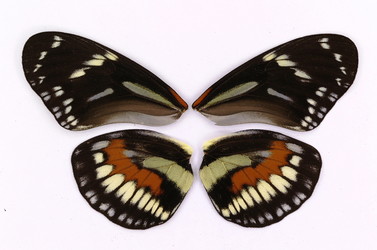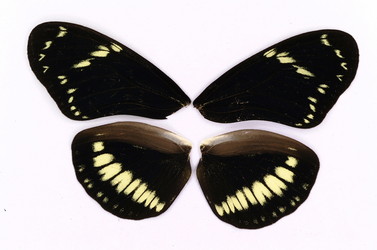Heliconius hecuba
Margarita BeltránIntroduction
Etymology: Hecuba was King Priam of Troy's wife and mother of 19 children by him, the most famous being Hector, Cassandra and Paris. When her youngest son Polydoris was killed by the king of Thrace, she put out his eyes and murdered his sons. The stories about her end vary: she committed suicide by jumping into the Hellespont, was killed or turned into a bitch. Hecuba is found in the Iliad and the Aeneid. She also appears in the plays Hecuba and The Trojan Women by Euripides and is mentioned in Shakespeare's Hamlet (Hecuba).
Characteristics
Early stages: Females usually place 10 to 30 eggs in growing shoots and tendrils of the host plant. Early instar larvae have a green and yellow body with black bands. Mature larvae have black scoli and head, length is approximately 1 cm. Caterpillars are gregarious (Brown, 1981).
Adult: Heliconius hecuba butterflies are black with a variety of yellow or white bands or spots on forewings and/or hindwings.
Geographical Distribution
Heliconius hecuba is distributed in the north of the Andes. This map shows an approximate representation of the geographic distribution of this species. The original data used to draw these maps are derived from Brown (1979) which is available at Keith S. Brown Jr. (1979). Ecological Geography and Evolution in Neotropical Forests.
Habits
H. hecuba occurs from 1,000 to 2,400 m in cloud forest. Usually, individuals fly rapidly and in the canopy.
Hostplant: H. hecuba larvae feed primarily on plants from the subgenus Granadilla from Simplicifoliae, Lobatae, and Kermesinae sections (Brown, 1981).
References
Brown, K. S., Jr. 1979 Ecologia Geográfica e Evolução nas Florestas Neotropicais. Campinas, São Paulo, Brasil: Universidade Estadual de Campinas.
Brown K. S. 1981 The Biology of Heliconius and Related Genera. Annual Review of Entomology 26, 427-456.
"Hecuba." Encyclopedia of Myths. http://www.mythencyclopedia.com/Go-Hi/Hecuba.html. [Accessed Jul 1, 2008].Illustrations of new species of exotic butterflies, selected chiefly from the collections of W. Wilson Saunders and William C. Hewitson. London, John Van Voorst. (9): [13-14], [25-26], [83-84], pls. [7], [13], [42] (2 January 1854), (10): [87-90], [97-98], pls. [44-45], [49] (3 April 1854).
Title Illustrations

| Scientific Name | Heliconius hecuba |
|---|---|
| Location | Ecuador collected by K. R. Willmott |
| Specimen Condition | Dead Specimen |
| Sex | Female |
| Body Part | Wings |
| View | Ventral |
| Image Use |
 This media file is licensed under the Creative Commons Attribution-NonCommercial-ShareAlike License - Version 3.0. This media file is licensed under the Creative Commons Attribution-NonCommercial-ShareAlike License - Version 3.0.
|
| Copyright |
©

|
| Scientific Name | Heliconius hecuba |
|---|---|
| Image Use |
 This media file is licensed under the Creative Commons Attribution-NonCommercial-ShareAlike License - Version 3.0. This media file is licensed under the Creative Commons Attribution-NonCommercial-ShareAlike License - Version 3.0.
|
| Copyright |
©

|
About This Page

University of Cambridge, Cambridge, UK
Correspondence regarding this page should be directed to Margarita Beltrán at
Page copyright © 2010
 Page: Tree of Life
Heliconius hecuba .
Authored by
Margarita Beltrán.
The TEXT of this page is licensed under the
Creative Commons Attribution-NonCommercial-ShareAlike License - Version 3.0. Note that images and other media
featured on this page are each governed by their own license, and they may or may not be available
for reuse. Click on an image or a media link to access the media data window, which provides the
relevant licensing information. For the general terms and conditions of ToL material reuse and
redistribution, please see the Tree of Life Copyright
Policies.
Page: Tree of Life
Heliconius hecuba .
Authored by
Margarita Beltrán.
The TEXT of this page is licensed under the
Creative Commons Attribution-NonCommercial-ShareAlike License - Version 3.0. Note that images and other media
featured on this page are each governed by their own license, and they may or may not be available
for reuse. Click on an image or a media link to access the media data window, which provides the
relevant licensing information. For the general terms and conditions of ToL material reuse and
redistribution, please see the Tree of Life Copyright
Policies.
- First online 18 February 2007
- Content changed 01 July 2008
Citing this page:
Beltrán, Margarita. 2008. Heliconius hecuba . Version 01 July 2008 (under construction). http://tolweb.org/Heliconius_hecuba/72919/2008.07.01 in The Tree of Life Web Project, http://tolweb.org/











 Go to quick links
Go to quick search
Go to navigation for this section of the ToL site
Go to detailed links for the ToL site
Go to quick links
Go to quick search
Go to navigation for this section of the ToL site
Go to detailed links for the ToL site